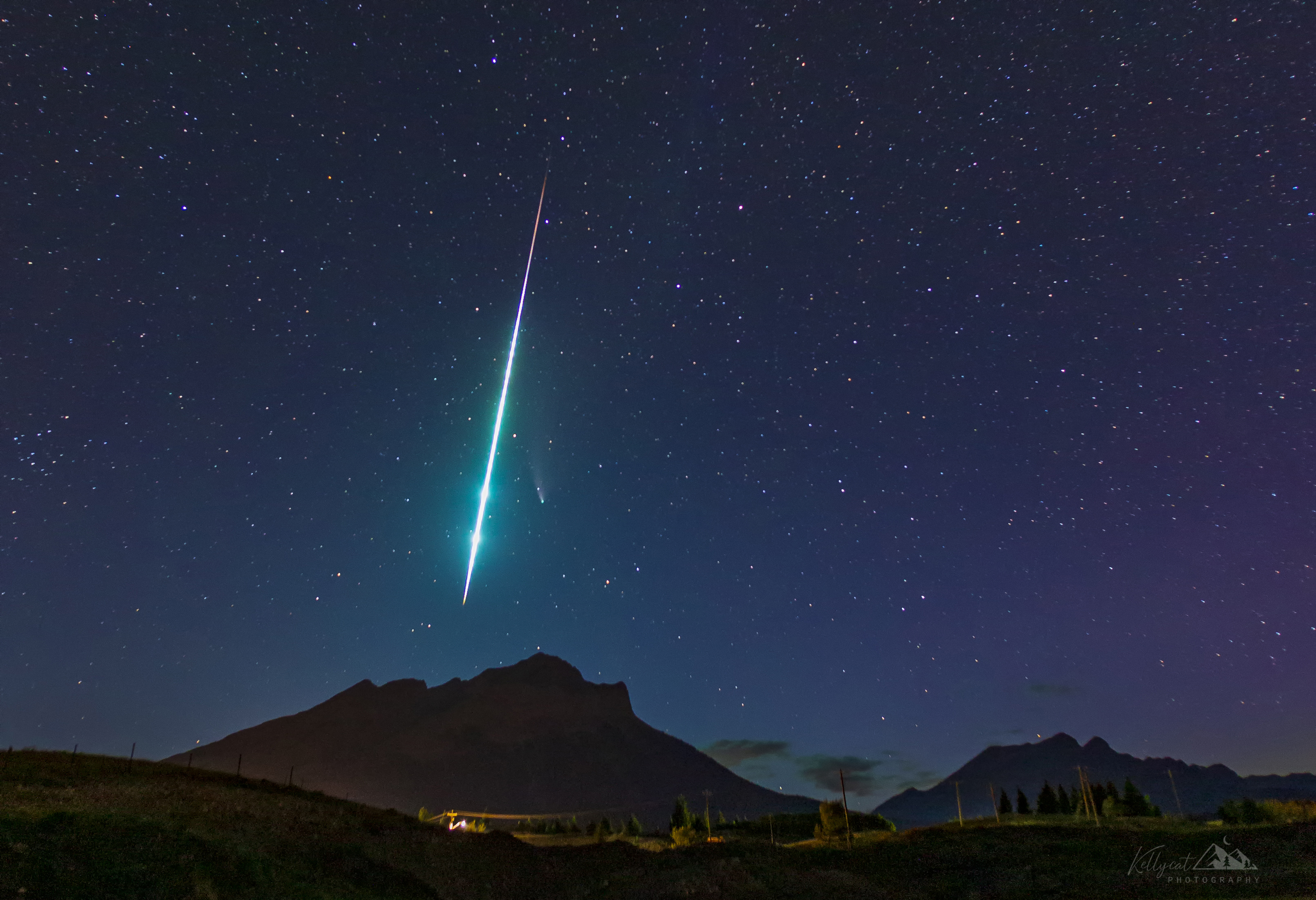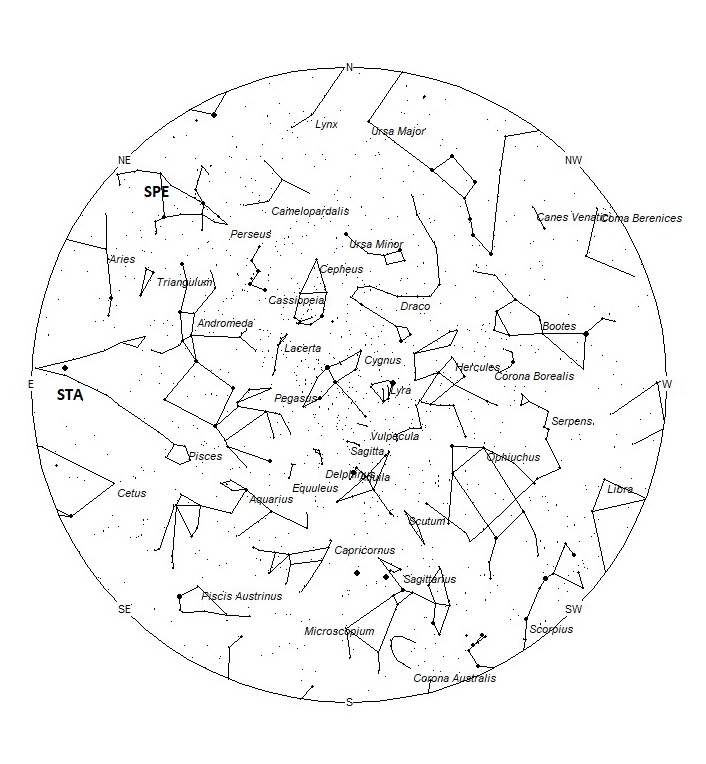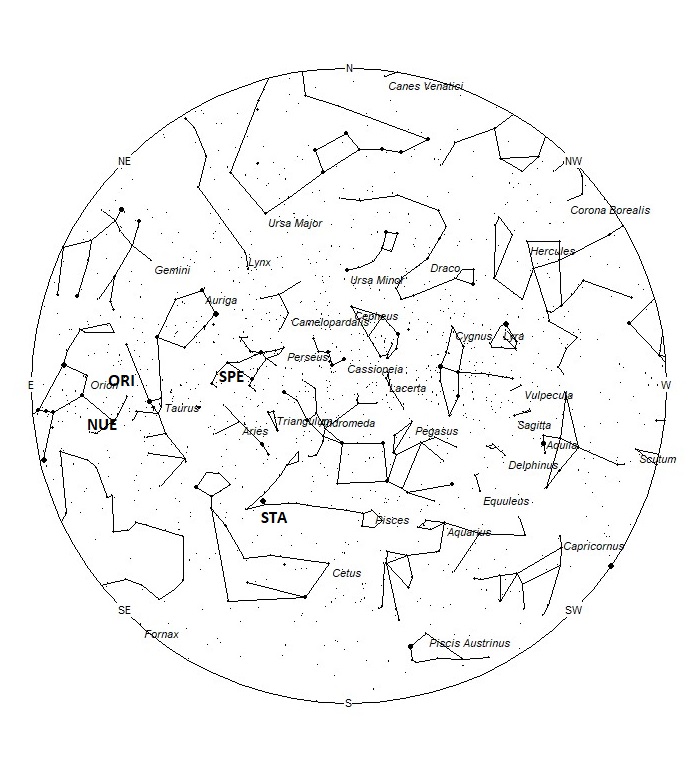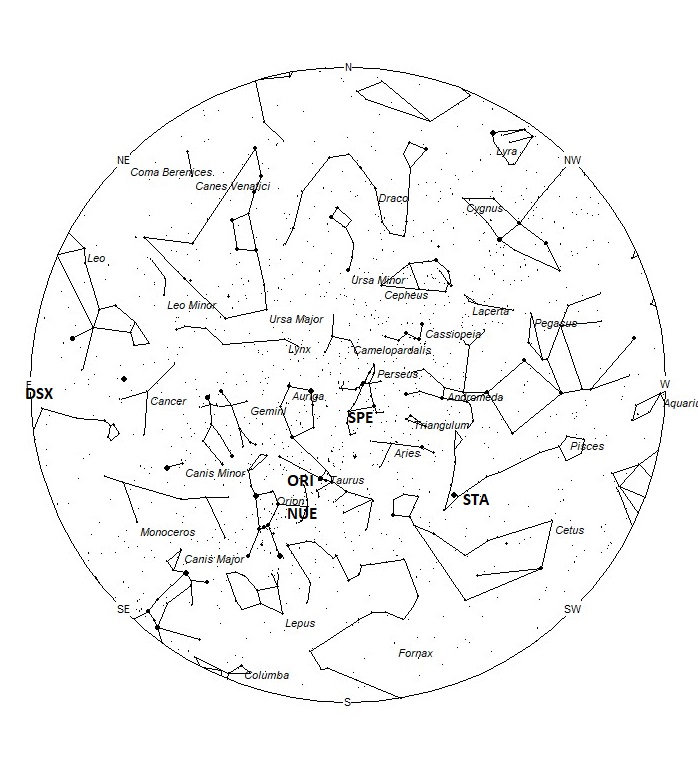
During this period, the moon reaches its first quarter phase on Wednesday September 23rd. At this time, the half-illuminated moon is located 90 degrees east of the sun and sets near 2300 local daylight saving time (LDST). This weekend the waxing crescent moon will set during the early evening hours and will not interfere with meteor observing. The estimated total hourly meteor rates for evening observers this week is near 4 as seen from mid-northern latitudes and 3 as seen from tropical southern locations (25S). For morning observers, the estimated total hourly rates should be near 14 as seen from mid-northern latitudes (45N) and 10 as seen from tropical southern locations (25S). The actual rates will also depend on factors such as personal light and motion perception, local weather conditions, alertness, and experience in watching meteor activity. Note that the hourly rates listed below are estimates as viewed from dark sky sites away from urban light sources. Observers viewing from urban areas will see less activity as only the brighter meteors will be visible from such locations.
The radiant (the area of the sky where meteors appear to shoot from) positions and rates listed below are exact for Saturday night/Sunday morning September 19/20. These positions do not change greatly day to day so the listed coordinates may be used during this entire period. Most star atlases (available at science stores and planetariums) will provide maps with grid lines of the celestial coordinates so that you may find out exactly where these positions are located in the sky. A planisphere or computer planetarium program is also useful in showing the sky at any time of night on any date of the year. Activity from each radiant is best seen when it is positioned highest in the sky, either due north or south along the meridian, depending on your latitude. It must be remembered that meteor activity is rarely seen at the radiant position. Rather they shoot outwards from the radiant, so it is best to center your field of view so that the radiant lies at the edge and not the center. Viewing there will allow you to easily trace the path of each meteor back to the radiant (if it is a shower member) or in another direction if it is a sporadic. Meteor activity is not seen from radiants that are located far below the horizon. The positions below are listed in a west to east manner in order of right ascension (celestial longitude). The positions listed first are located further west therefore are accessible earlier in the night while those listed further down the list rise later in the night.
These sources of meteoric activity are expected to be active this week.
.
We are now encountering inbound debris from comet 2P/Encke, which has its source superimposed upon the anthelion radiant. Since it has been shown that meteors from 2P/Encke are more numerous than the Anthelions, we will recognize this activity as the Southern Taurids (STA). Like the anthelion radiant, the source area is large and diffuse so observers can be liberal with the shower association of these meteors. The southern Taurids are active for three months and reach maximum activity on November 3rd. The current position of the STA radiant lies at 01:12 (018) +06, which places it in southern Pisces, 2 degrees southeast of the 4th magnitude star known as epsilon Piscium. The radiant is best placed near 0200 LDST, when it lies highest above the horizon. Rates are expected to be near 2 no matter your location. With an entry velocity of 27 km/sec., most activity from this radiant would be slow moving.
The September Epsilon Perseids (SPE) are active from August 27 through September 24 with the peak occurring on September 9th. The radiant is currently located at 03:43 (056) +40. This position lies in central Perseus, 2 degrees southwest of the 3rd magnitude star known as epsilon Persei. The radiant is best placed near 0500 LDST, when it lies highest above the horizon. Rates are expected to be near 1 as seen from the northern hemisphere and less than 1 as seen from south of the equator. With an entry velocity of 65 km/sec., most activity from this radiant would be swift.
The nu Eridanids (NUE) were co-discovered by Japanese observers using SonotoCo and Juergen Rendtel and Sirko Molau of the IMO. Activity from this long-period stream stretches from August 24 all the way to November 16. Maximum activity occurs on September 24th. The radiant currently lies at 04:53 (073) +06, which places it in western Orion, 1 degree southeast of the 3rd magnitude star known as Tabit (Pi³ Orionis). This area of the sky is best seen during the last dark hour before dawn when the radiant lies highest in a dark sky. Current rates are expected to be near 1 per hour during this period no matter your location. With an entry velocity of 67 km/sec., the average meteor from this source would be of swift velocity.
Activity from the Orionids (ORI) should begin this week from a radiant located at 05:06 (077) +15. This area of the sky is located in northwest Orion, 5 degrees southeast of the bright orange star known as Aldebaran (alpha Tauri). This area of the sky is best seen during the last dark hour before dawn when the radiant lies highest in a dark sky. Maximum activity is not until October 21st so current rates would be less than 1 per hour no mater your location. With an entry velocity of 66 km/sec., the average meteor from this source would be of swift velocity.
The Daytime Sextantids (DSX) are not well known due to the fact that the radiant lies close to the sun and these meteors are only visible during the last couple of hours before dawn. The radiant is currently located at 9:44 (146) +02. This position lies in western Sextans, 3 degrees northeast of the 4th magnitude star known as Ukdah (iota Hydrae). This area of the sky is best placed in the sky during the last hour before dawn, when it lies highest above the horizon in a dark sky. Current rates would be most likely less than 1 per hour no matter your location. Spotting any of this activity would be a notable accomplishment. With an entry velocity of 33km/sec., most activity from this radiant would be of medium-slow speed.
Morning sporadic rates are expected to be near 10 per hour as seen from mid-northern latitudes and 7 as seen from tropical southern latitudes. Evening rates should be near 3 as seen from the northern hemisphere and 2 as seen from tropical southern latitudes. The list below offers the information from above in tabular form. Rates and positions are exact for Saturday night/Sunday morning except where noted in the shower descriptions.
The list below offers the information from above in tabular form. Rates and positions are exact for Saturday night/Sunday morning except where noted in the shower descriptions.
| SHOWER | DATE OF MAXIMUM ACTIVITY | CELESTIAL POSITION | ENTRY VELOCITY | CULMINATION | HOURLY RATE | CLASS |
| RA (RA in Deg.) DEC | Km/Sec | Local Daylight Saving Time | North-South | |||
| Southern Taurids (STA) | Oct 10 | 01:12 (018) +06 | 27 | 02:00 | 2 – 2 | II |
| September epsilon Perseids (SPE) | Sep 09 | 03:43 (056) +40 | 65 | 05:00 | 1 – <1 | II |
| nu Eridanids (NUE) | Sep 24 | 04:53 (073) +06 | 67 | 06:00 | 1 – 1 | IV |
| Orionids (ORI) | Oct 21 | 05:06 (077) +15 | 66 | 06:00 | <1 – <1 | I |
| Daytime Sextantids (DSX) | Sep 28 | 9:44 (146) +02 | 33 | 10:00 | <1 – <1 | IV |
 American Meteor Society
American Meteor Society



Thanks for the update Robert.
I also have been very interested in the night ski and meteors ect. I am a Gemini in the ski. I want to say thank you very much for all of this meteor information. I will be observing carefully from now until November. My daughter and I have seen a very large meteor back in early 2000. It was amazing to see with her, although she is not as interested in the ski as I am. I do believe it was a fire ball that we saw NE of us here in Roseburg Oregon!
I would like to say that I have loved Meoter showers sience I was young. And then when I got married I lucked out, my husband likes them also. We watched them as often as the weather would permit. And Becuse we ran heavy equipment & moved around with it , we had the operatunity to observe from some of the best places. But now later in life, I’m 62, I have a girlfriend who comes over, & we go to the darkest place we know of, & get on the roof of the car or truck, mine changes, lay down a blanket & lay on our backs until the sun comes up. I have never been disappointed. Thanks.